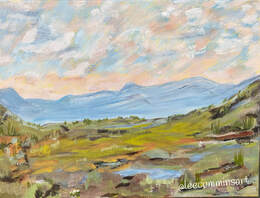 "The stories of our mind, become the stories of our lives." I'll never forget this saying; from the CEO of a company, I was involved with a few years back. What we feed ourselves comes out in our skin, hair, nails and our figure. Yes, let me tell you, I have a sweet tooth and know if I give in to the chocolate cravings, the scales find out very quickly. So too is what we feed our brain. You know, the little nasty conversations we have with ourselves. Those snippets of useless information such as, I'm not good enough, no one will like this, I have no talent, I'm a fraud, I'm useless at this. Toxic conversations we have with ourselves. We would never talk to our best friend, family member or neighbour this way, yet we allow ourselves to participate in this one-way hurtful conversation. What if we turned the conversation on ourselves and spoke as though we were speaking to our nearest and dearest, replacing admonishment with praise? Hurt for joy, negative for positive, sadness for happiness? Imagine how we would feel about what we do in life. It doesn't matter if we're talking about creating art, gardening, writing or any matter of hobbies or tasks. Being kind to others starts with being kind to ourselves. Next time you are about to have a nasty conversation with yourself, take a breath and replace the negative chitty-chatter with a healthy dose of positivity and praise. You know you can change your story, it might just change your life. Do you have positive conversations with yourself? How do you stop negative self talk? Let us know in the comments below.
0 Comments
 I remember years ago, I used to go to the hairdressers to get my hair streaked. Sitting in front of the mirror with the cap on, hair pulled through tiny holes sticking out everywhere, it was an ugly sight. (i'm giving my age away!) As I sat there waiting for the colour to develop I would put up with it knowing that when the cap came off, my colour would be vibrant and my hair would feel great. Of course, there were many steps to getting my hair from looking like I had put my finger in an electric socket to coiffed and ready to take on the world with my new hairdo. Can you relate? So often in art classes, I hear from the room many times, OMG, this is ugly, followed by a big sigh. Sometimes, I am asked for some more substrate to start again. The fact is nothing is beautiful during a process. Building a home, you start with an empty block, building on it and developing it over years to get it where it is today. Baking a cake or cooking your favourite dish, you wouldn't eat part of it during the process, it would taste awful without all the ingredients put through the process. The same is true when creating art. It is a process, artwork has many layers to it. Building on it, lovingly adding a brush mark here, a pen stroke there, mixing colours, adding subtracting, highlighting, toning down, mark making, pulling back. All of the different components make up the work. All artwork as with everything that has a process goes through an ugly stage. We wouldn't get up from the hairdresser chair and with the cap on and say "hey, this is ugly, I'm giving up on getting my hair done." or "Stop building my house, I wanted a landscape garden with a path to walk up to the front door, even though it's not there yet." Get my drift? Art work is the same, it takes time, patience, perseverance, vision and faith. Not every artwork will work out how you thought, it could work out even better. If you give up, or walk away and not go back to it you will never know and you will never learn. I find if I am stuck and not sure what to do, I walk away for a little while and come back, looking at it with new eyes, a new perspective. I work through what I need to do to take it from the ugly stage to developing it further. You never know you might just make your most perfect masterpiece if you work through the ugly stage. Does your artwork go through an ugly stage? How do you overcome it? Share your ideas and leave your comment below.  En plein air, a French phrase meaning “in the open air,” describes the process of painting a landscape outdoors. Artists venture into natural settings, to capture the play of light, colour, and atmosphere from nature. When I started back painting in 2020, often we would grab a couple of camping tables and sit in the backyard and paint our beautiful outlook. I forgot how much I loved being in fresh air, sun shining and being at one with nature. Last year I had planned to start running en plein air mornings in the local area. With personal illness and family matters, it went on the backburner, until now! After a few promptings from some of my classes, I realised now was the time to execute these monthly jaunts into nature. Funny, the website page had sat there for the best part of 12 months waiting for the right time. I am looking forward to the first one coming up in just a few weeks. The artwork above is from the day I went out and scouted around for some lovely scenery. Using a sketchbook, pencils and some Gouache I was able to capture the day in my sketchbook. The colours, the shadows and the feeling. It was wonderful to be there amongst the bird life, the chitter chattering and the different bugs that make ever so slight noise. Every now and the, the feet on sand of the runners would break the sounds of the bush. It is a fantastic experience and something I think is great to try. Any level of artist can enjoy a paint out in nature. You can take what is in front of you and put your spin on it, your interpretation of what you see. You don't have to have a swag of supplies, you can take minimal supplies or go all out. I have put together a comprehensive list of what you could take with you. Obviously, you can be as thrifty with your supplies as you wish. If you would like to take a look at the list and even join me you can find out more here. Do you do paint outs? What do you take as your essentials? Share below your best tips for en plein air supplies.  A few years ago, I did a course on using a limited palette. I found it to be a stretch initially using just a few colours and black and white. So what is a limited palette? Imagine you're baking biscuits, but you only have a few ingredients in your pantry. A limited palette in art is like that, it's when you choose to work with only a small set of colours instead of having every colour available, just like having only a few ingredients for your biscuits. So, instead of using every colour in your art supplies kit, you might pick just three or four main colours, like red, blue, yellow, and maybe white. I also like to have black or Payne's Grey. With these colours, you can mix and blend them together to create all sorts of new and exciting colours. Working with a limited palette is a fun challenge. It helps you focus on learning how colours work together and how to mix them just right to get the shades you want. Plus, it can make your artwork look really harmonious and cohesive because all the colours are related to each other, just like all the ingredients in your biscuits work together to make them taste great! One of the main reasons I love to work with a limited palette, it makes me stretch myself with blending colours to get just what I need and want for a particular piece. The photo of a work in progress in this post is using a limited palette of cobalt blue, Payne's grey, cadmium yellow and burnt sienna with white for adjusting tones. Mixing colour with a limited palette is one of my favourite ways to paint. If you are just starting out, you can start with a few colours and mix your colours without buying every tube on the shelf! So, think of a limited palette as your artistic recipe. You might not have every colour in the world, but with a little mixing and experimenting, you can create something really special! You can find some of my favourite tools here If you have favourite colours you use in a limited palette, why not share them in the comments below.  I once knew a lady who spent so much time talking about how little time she had that she never actually got anything done. We all have the same mount of time in our day 1440 minutes to be precise. It is how we choose to use those minutes which makes a difference. Personally, I am a paper diary gal, I write everything in it and schedule time for particular tasks. Yes, I schedule medical appointments, classes I run, business tasks, cleaning the house and also studio or painting time. I also have non-negotiable times which often my painting or studio time falls into that category. Non-negotiable means it must be something super important for me to schedule over that time. If your hobby of art is important to you, you will schedule in time to spend pursuing it. It may be as little as 30 or 40 minutes a day. The first step is giving ourselves permission to take the time to enjoy our hobby, I don't know about you, as I was growing up the fun stuff could only be done when the work was finished. Our brains have been programmed to allow ourselves pleasurable pursuits after the work, chores and responsibilities have been completed. Guess what? They never end, they never are completed so we don't end up enjoying our hobby, art, painting, knitting or any other hobby. Think about the last time you "indulged" in your hobby or a pleasurable pursuit. How did it make you feel? Did you feel calmer, less stressed and revitalised? If like me, the answer is yes, this is the time to grab that diary, planner, phone and schedule in the time to enjoy your hobby. You are no good to anyone else or yourself if you are frazzled, stressed or feeling down. Making our art or hobby a priority is helping ourselves to a better, less stressed and more rounded life. Leave a comment below on how you prioritise your time to pursue your hobby or what you plan to do now. I would love to see your ideas.  Acrylic paint was my way back into art and I loved it that's for sure. I signed up for some on-line art classes during lock down and was exposed to the world of mixed media. This changed everything for me and my art. Also, attending art classes where you could experiment and use different mediums opened my eyes and hands to different textures and styles. So what is mixed media I hear you ask. Mixed media is the combination of two or more art mediums into one piece of art. Some examples would be painting a watercolour picture and then adding pen or ink to the works or using acrylic paint and then adding oil pastels to the piece. Of course, you can have multiple mediums in one piece to get your desired effect. I tend to use soft oil pastels and or charcoal after I have completed the acrylic artwork. I find adding another medium gives you some amazing affects you can't necessarily achieve using the one medium. Mixed media can be used on all genres of art whether you love abstract, realism, expressionism or impressionism. Vincent van Gough before his early death had been experimenting with colour combinations and mixed media, although it hadn't been named at that stage. Mixed media for me is a new and exciting way to find expression and texture in my artwork, particularly as my art is inspired by nature and nature is full of texture and colour.  Art can be a relaxing past time, a hobby, or your way of making a living. No matter what role art plays in your life, creating art teaches us to problem solve. Looking at a piece of art and seeing that it doesn't quite work or quite speak to you means stepping back and looking at what is working well, what is ok and what isn't working. When I was in a corporate role, we often as a management team would sit down and analyse the business based on what's working, what's not, what can we do to improve it. As artists we do the same. We look at our artwork in the same way as a businessperson would look at their operations. Art teaches us to observe, analyse and work through a specific problem to overcome what is not working. Do we add some texture, shape, tone, or colour? Do we make this come forward, back, paint over it, leave it. What will make this piece speak to the viewer? This process carries over into every area of our lives. These skills are transferable and valuable to our growth, increasing our capacity for thinking in new and diverse ways. We determine what we need to do to ensure a better and different outcome for a specific problem. The benefits of taking time out for creativity are endless. Keep creating! |
AuthorLee Cummins is a mixed media artist, workshop and art class facilitator. Archives
July 2024
Categories
All
|

 RSS Feed
RSS Feed
